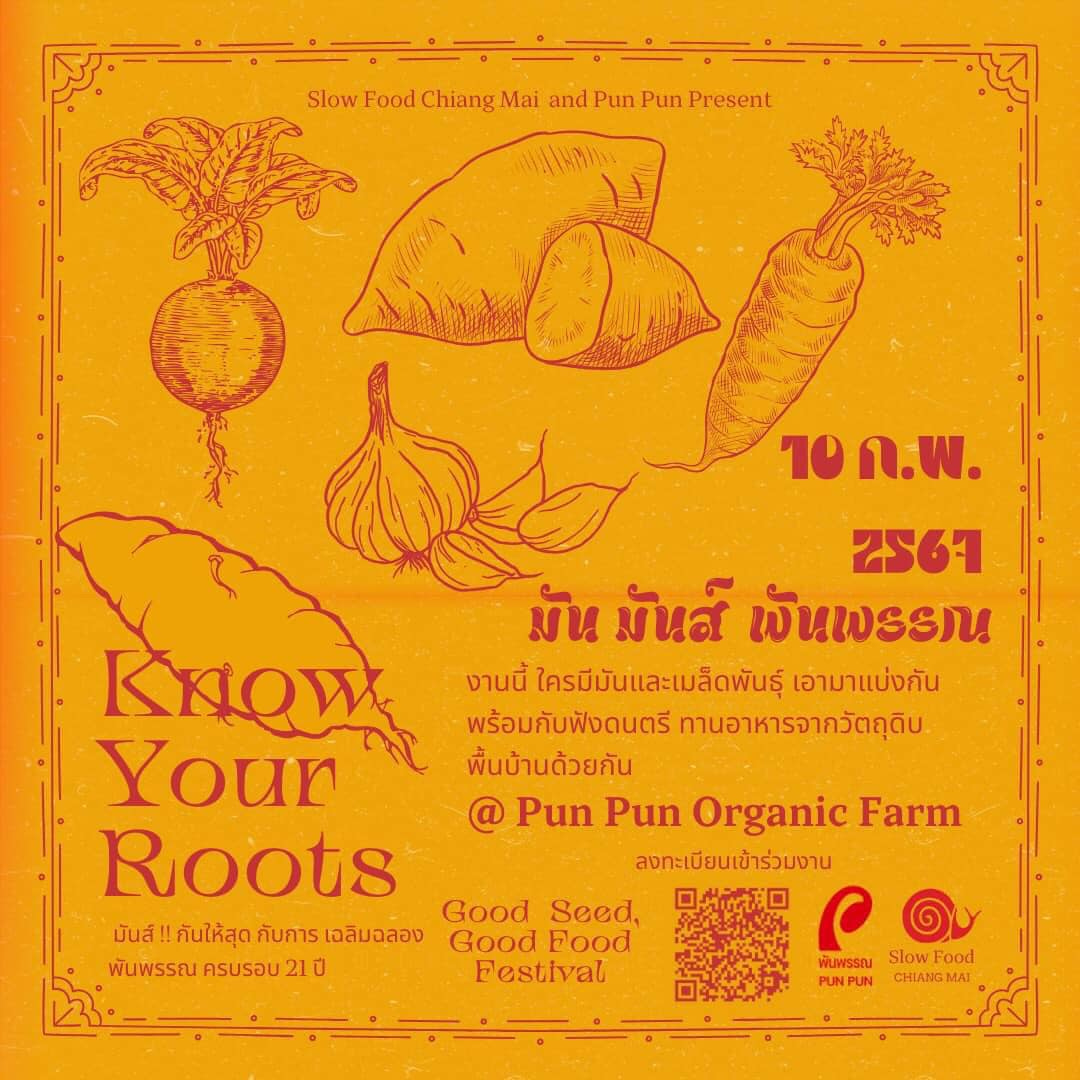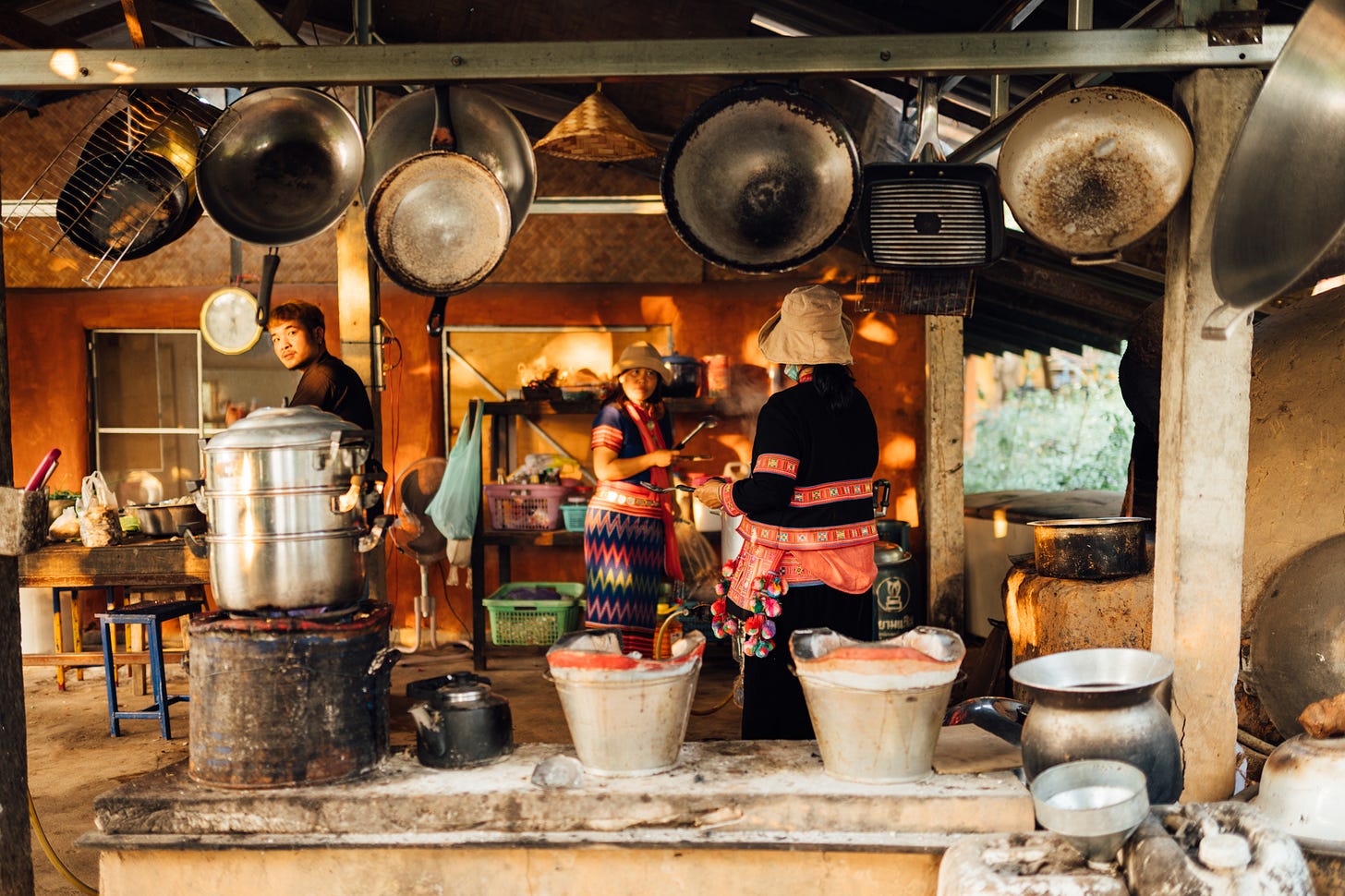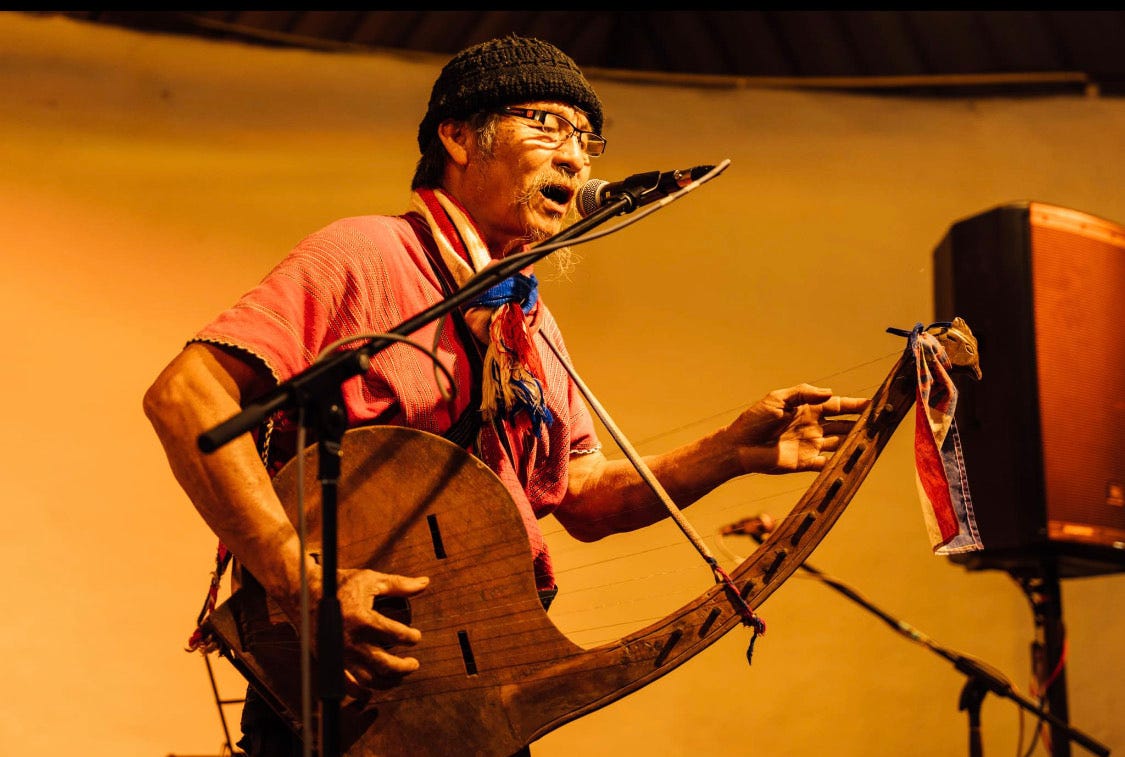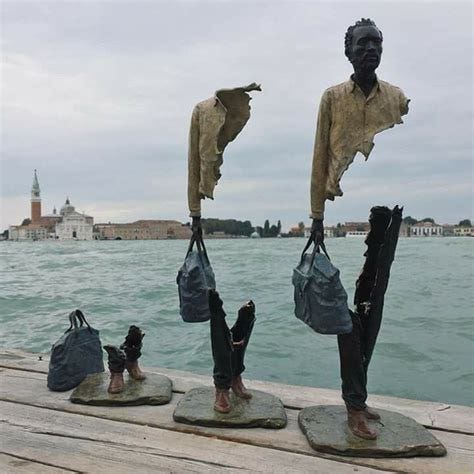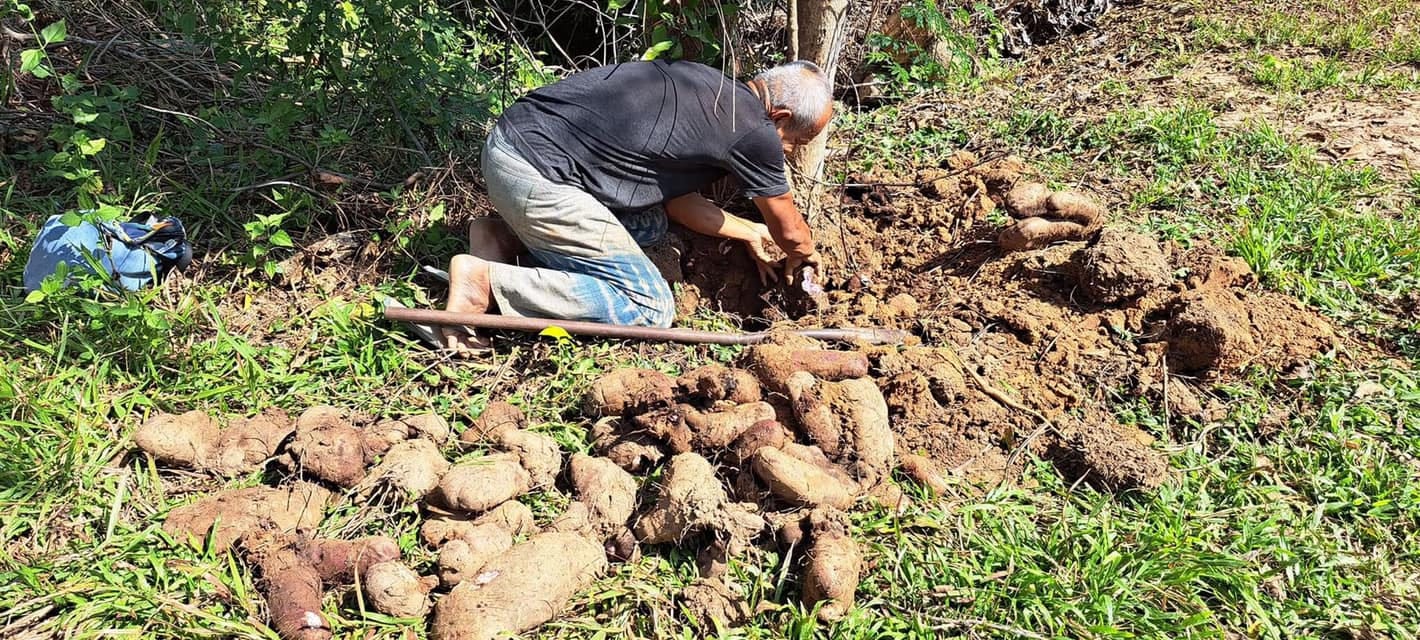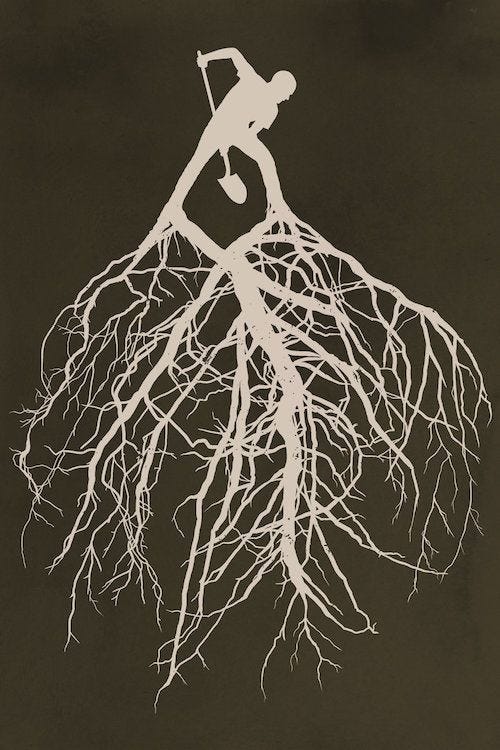Last week our experimental seed-saving eco-village, Pun Pun celebrated its 21st year! Every year we host a reunion and invite all past members of our community who have since moved on, as well as anyone who has attended our workshops or been affected positively by us in any way to return and have some fun together. This year, we decided to team up with Chiang Mai’s blossoming “slow food” movement with the hopes of not only hosting a party but taking advantage of what has become a much beloved, well-attended hoedown by also weaving in opportunities for learning. In partnership too with various indigenous “hill-tribe” friends we all agreed that our theme should focus on roots, both those pertaining to culture as well as the magical beings found residing just beneath our feet.
There is a rising interest worldwide in reimagining, revisiting and regenerating the widely lost art of communal living. Just last week I was invited to gather with like-minded friends to watch a free screening of a documentary call “Village of Lovers” by Ian Mackenzee that explored the efforts of a community in Portugal (Tamera) to co-create an ideal life for themselves based on the premise that humans’ inability to live together in radical intimacy is the root cause of many of our societal meltdowns. To be sure, many citizens of the world today are feeling called to place more effort into merging their personal lives with the lives of others, maybe in a less, um, sexual way, than the unique community of Tamera, but the core of this yearning seems to be, simply put, rooted in a universally human need to see and be seen, a need that many of us who have adopted modernities uber individualistic approach to life feel is not now being met.
Over the years we have hosted many visitors and volunteers at Pun Pun who have spent time at Tamera. We have also had the pleasure of having members of other impressive experimental communities like Quail Springs, a community based in California, U.S.A., Aurouville, a small city founded on the teachings of Sri Aurobindo located in Pondicherry, India, among others. They all have offered us inspiration and I have been told that we have, in turn, offered them inspiration as well. Although seldom do we all agree on everything, it is usually within the curious explorations of the aversions and attractions that arise from our comings together that strengthen our dedication and aspirations to be ever able to adapt well and remain open to more beneficial efforts.
Over the last two decades, many of the past participants of workshops we have led at Pun Pun have also gone on to create their own communities. It is touching to see what has begun to sprout from the collective nourishing of seeds originally shared at our farm that have since cross-pollinated with yet more ideas and slowly grown into their own unique forms. All healthy ecosystems require diversity and it is encouraging to not see mere duplications of what we are doing but to instead be witnessing the beauty of evolving, never-before-seen interpretations of how to live well in a Place.
As I grow deeper into the soils of my own adopted home, it is becoming more clear that, as we evolve together, as we change and adapt in wildly exciting new and ancient ways, remembering our roots is just as important as building new worlds. There are seemingly endless tales that speak of foolish ones who build their homes on sand. For a forest to flourish it needs deep roots that have strong memories and can articulate clearly all the mistakes and triumphs of the past and know, with well articulated details, all the subtle and not-so subtle aspects of the Sacred Agreements that must not be broken at any cost no matter what intriguing new world we wish to bring into view.
One of the main reasons efforts to build communities during the 1960’s in the United States failed was due to the deliberate choice made then by open-minded, well-intended hippies to cut themselves off from their roots. To be fair, in looking at what the dominant zeitgeist of that time was, it should be of no surprise why the young people of that generation wished to separate themselves so completely from their predecessors. Yet woe to those among us who follow passion with so much vigor that we neglect to see the whole story. For nothing is as black and white as our excited minds often attempt to convince us of. Was much, possibly most, of what the “white” adults living in North America were thinking desperately out of touch, outdated, harmful? Yes. For sure. But not all of it. And this is the case with all things. We must strive thus to go deeper, as do the roots of the Black Gum tree, to find what life-serving nectar is hidden beneath the boring, amnesiatic sorrow of our times and re-member the forgotten wisdoms hidden in plain sight that can still serve us now. It’s all there. Like an overlooked seed. We just have to look deeper. And in our case, in these strange times, way deeper. Good songs, poetry and well told Myth can help us do this.
Pgakenyaw Elder Pati Thongdee offering encoded memories of how to live well.
…
Before “Europeans” set foot on Turtle Island and invented the idea of “whiteness”, they too, like the peoples whose lands they invaded hailed from colorful, in-tact cultures. Although much of the magic of this had already been lost to bizarre versions of Christianity and other efforts of empire to dilute these life feeding, Place-based relationships, the vestiges of memory of these ways were still known. Yet, for reasons lost to the tides of time as well as very deliberate efforts to cover up retellings of events deemed undesirable, myriad unthinkable acts which occurred to the well-rooted ancestors of the would be “New World” that caused them to flee their homes resulted in mad, rushed attempts to recreate what had been lost. The trauma that rose from centuries of fear was never properly metabolized. (Sound familiar?) Having been forced to flee swiftly, with griefs unhonored if not altogether neglected entirely, not only were most of the actual possessions that belonged to these immigrants left behind but so too were the sacred ritualized practices which had for millennia kept them rooted in Right Relation. As such, the sadness that arose from being without a land-rooted existence, unheld and misguided without the care of true elders and Place-based myths capable of transmuting grief into beauty transformed instead into greed, hatred, forgetfulness, and all the other typical variations of ignorance we see manifesting around the world today in rather unbecoming forms. Roots thus, after colonization crystalized, if present at all, were just barely recognizable, shallow under the surface of someone else’s land, not deep enough to hold any real culture, not intelligent enough to build a home strong enough to care properly for future generations. Adrift, with no sacred agreements to form any meaningful relation.
And as it goes for for the cultural origins of a people, the same is true of actual roots. For as humans are, so goes the land. A sick people will inevitably result in sick soil. As Europeans allowed their misplaced grievances to construct ideologies that justified land theft and slavery, soon, along with the spread of bland, cultureless peoples, so too did lands with little diversity, few seeds, few roots, few animals and few good stories come into view too. As angry “white” guys forfeited ceremony for efficiency, unceremoniously acquired meats and chemically grown potatoes became the norm. This trend now spreads to all corners of the world. The endless sea of underground roots being dug up to make space for GMO corns, and a handful of other enslaved foods whose goal it is to make a profit from, and not a life. As the roots leave, so too does our memory of in-tact cultural life.
Yet hidden in a handful of uncontaminated seeds is the genetic memory of the entire story, patiently waiting for the proper conditions to allow it to reveal its true nature and awe inspiring ability to reproduce and offer abundantly. And with this, reside too the mythically encoded Original Agreements. Without these two pillars of culture, communities cannot survive for very long. An excited array of high ideals isn’t enough. No roots, no fruit. It’s that simple. Which is why we made sure to invite elders to our celebration this year, and along with them, their actual roots. We were fortunate to host memory keepers from Pgakenyaw, Akka, Lisu, and Lahu tribes respectfully, as well as several Spiritual elders of the Theravada and Mahayana traditions. We spoke collaboratively of Seed and cultural memory. We shared poetry and song. We ate meals made from nearly extinct roots that have been greatly harmed by monocultural farming and monocultural thinking. We made for them a space to be heard and felt and seen, re-membered and well fed.
Pun Pun Founder and legendary seed-keeper Jon Jondai gathers rare roots.
…
As we shared seeds, tubers, stories, laughter and tears, we all vowed in myriad unique ways to keep it all very much alive. We will actively continue to grow these seeds, not merely by preserving them in museums or taking pretty pictures of them to post on social media. And they, in turn will grow us... We will remember them and they will re-member us. For if they do not thrive, neither shall we. For our cultural roots cannot grow without theirs growing healthily too. Our his/herstories, food systems, our economies, our spiritual and educational aspirations, our dreams etc. are all woven together like the mycorrhizal networks surrounding roots under holy soil and can only function beautifully if cared for intergenerationally amidst well-nurtured, cross-cultural collaborations. If the soils of our understandings lose vitality than our roots will not grow deep enough for our communities to survive very long. Knowing this, as difficult as it sometimes can be, we never claim that our way is thee way. As the underworld thrives in an ever-churning mystery of diverse chaos and chance that offers myriad, mineral rich fruits that keep us all alive, so too do we need to respect the wildly diverse expressions of all peoples own versions of Truth.
Our elders know how to do this. Wild foods and wild lands do too. Sadly however, due to all the amnesia wrought on us by modernities curious approach to “life”, we have lots of old people but few genuine elders. Just like we have lots of GMO corn. Foods and thoughtways that corporate serpents have sought to rid the world of in favor of a narrow view do not offer us the stability needed for cultural roots to grow deep enough. Without the kind of mythological memory true elders, organic seeds and wild roots possess any effort to build anything “new” are likely to be in vain. The same demons of fear and inadequacy that forced us all to leave home in the first place will certainly reign supreme again and again if the necessary space for roots to firmly reside is not provided (*war will never offer this space.). Our communities need elders. Our soils need ancient roots. Humanity desperately needs to regenerate deep memory. We need to grow human culture again. We all must know our roots.
*image by Rob Dobi
*Watch a short video of the Know Your Roots gathering here!
#maypeaceprevailonearth
#knowyourroots




